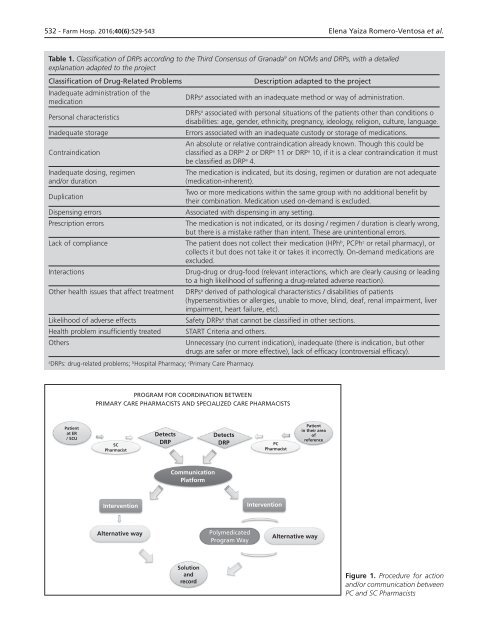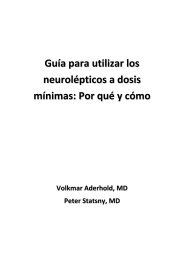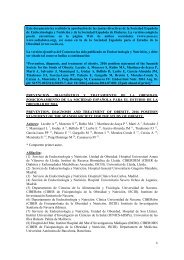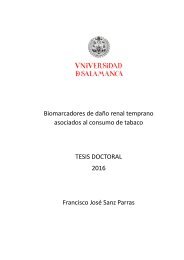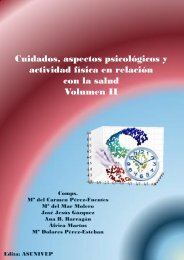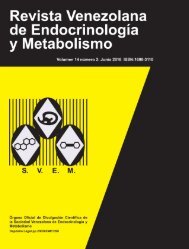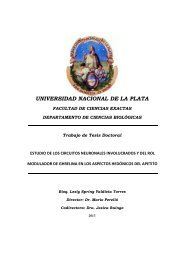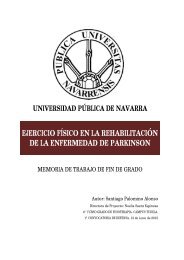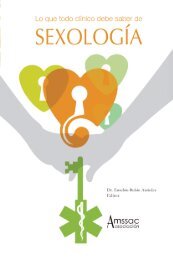Noviembre-Diciembre
156_v40n6(1)
156_v40n6(1)
You also want an ePaper? Increase the reach of your titles
YUMPU automatically turns print PDFs into web optimized ePapers that Google loves.
532 - Farm Hosp. 2016;40(6):529-543 Elena Yaiza Romero-Ventosa et al.<br />
Table 1. Classification of DRPs according to the Third Consensus of Granada 9 on NOMs and DRPs, with a detailed<br />
explanation adapted to the project<br />
Classification of Drug-Related Problems<br />
Description adapted to the project<br />
Inadequate administration of the<br />
DRPs<br />
medication<br />
a associated with an inadequate method or way of administration.<br />
DRPs<br />
Personal characteristics<br />
a associated with personal situations of the patients other than conditions o<br />
disabilities: age, gender, ethnicity, pregnancy, ideology, religion, culture, language.<br />
Inadequate storage<br />
Errors associated with an inadequate custody or storage of medications.<br />
An absolute or relative contraindication already known. Though this could be<br />
Contraindication<br />
classified as a DRP a 2 or DRP a 11 or DRP a 10, if it is a clear contraindication it must<br />
be classified as DRP a 4.<br />
Inadequate dosing, regimen<br />
and/or duration<br />
Duplication<br />
Dispensing errors<br />
Prescription errors<br />
Lack of compliance<br />
Interactions<br />
Other health issues that affect treatment<br />
Likelihood of adverse effects<br />
Health problem insufficiently treated<br />
Others<br />
a<br />
DRPs: drug-related problems; b Hospital Pharmacy; c Primary Care Pharmacy.<br />
The medication is indicated, but its dosing, regimen or duration are not adequate<br />
(medication-inherent).<br />
Two or more medications within the same group with no additional benefit by<br />
their combination. Medication used on-demand is excluded.<br />
Associated with dispensing in any setting.<br />
The medication is not indicated, or its dosing / regimen / duration is clearly wrong,<br />
but there is a mistake rather than intent. These are unintentional errors.<br />
The patient does not collect their medication (HPh b , PCPh c or retail pharmacy), or<br />
collects it but does not take it or takes it incorrectly. On-demand medications are<br />
excluded.<br />
Drug-drug or drug-food (relevant interactions, which are clearly causing or leading<br />
to a high likelihood of suffering a drug-related adverse reaction).<br />
DRPs a derived of pathological characteristics / disabilities of patients<br />
(hypersensitivities or allergies, unable to move, blind, deaf, renal impairment, liver<br />
impairment, heart failure, etc).<br />
Safety DRPs a that cannot be classified in other sections.<br />
START Criteria and others.<br />
Unnecessary (no current indication), inadequate (there is indication, but other<br />
drugs are safer or more effective), lack of efficacy (controversial efficacy).<br />
PROGRAM FOR COORDINATION BETWEEN<br />
PRIMARY CARE PHARMACISTS AND SPECIALIZED CARE PHARMACISTS<br />
Patient<br />
at ER<br />
/ SCU<br />
SC<br />
Pharmacist<br />
Detects<br />
DRP<br />
Detects<br />
DRP<br />
PC<br />
Pharmacist<br />
Patient<br />
in their area<br />
of<br />
reference<br />
Communication<br />
Platform<br />
Intervention<br />
Intervention<br />
Alternative way<br />
Polymedicated<br />
Program Way<br />
Alternative way<br />
Solution<br />
and<br />
record<br />
Figure 1. Procedure for action<br />
and/or communication between<br />
PC and SC Pharmacists


